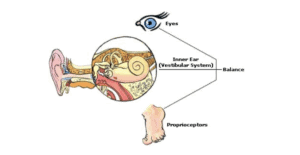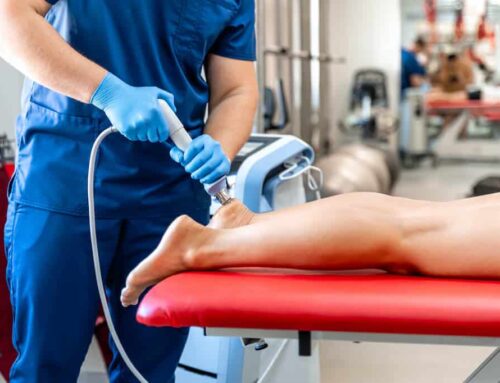Balance problems can vary, from just feeling a little woozy, to having your world rocked. You could be just a little light-headed, or you could feel like the room is spinning circles around you, and you can’t quite tell which way gravity is supposed to work. These feelings can happen when you’re in any position, and can seem to happen randomly. This can cause a lot of uncertainty in your confidence to move around, and can lead you to feeling stuck.
Many systems in your body play a role in balance. They include your vision, muscles, bones, joints, ligaments, vestibular system, nerves, and blood vessels. When you combine these systems, you have 3 major ones.
- Your vision – this one’s pretty clear cut – your eyes.
- Your vestibular system – this is the system inside your inner ear. This is where most balance problems occur.
- Your proprioceptive system. This is the system that is made up of your bones, joints, ligaments, and nerves all combined into one. It basically tells you where your body is, without you having to look. For example: You know your bag is in the back seat of the car, you can reach for it and locate it without looking.

By: home-remedies-for-you.com
Symptoms of balance problems:
- Sense of spinning (vertigo)
- Unsteady walking or loss of balance
- Wobbling when you stand on one leg
- Feeling faint, or lightheaded
- Vision changes and blurriness
- Confusion
Causes of Balance Problems
Balance problems can be caused by different conditions that affect one of the three primary systems outlined above.
Your vision
This one is the most straightforward to understand. Without good vision, you can’t see well around you. This can cause you to shuffle your feet, which disrupts your normal walking pattern and can cause you to lose balance.
Your Vestibular System
This one is a little more complicated. There’s this system inside your ear called your vestibular system. Imagine you’re looking at a clear plastic tube filled with water. Inside the tube there are these little hairs inside that stand up, called “cilia.”
When you hold the tube horizontally, the cilia stand up nice and tall. When you tilt it to the left, the water sloshes to the left side of the tube and the cilia bend that way. When this happens in your body, your body knows your head is tilted to the left side.
When there’s a problem with your vestibular system, this system is affected. This causes vertigo. Vertigo can feel like anything from slightly woozy or “air headed” to a full on merry-go-round on steroids.
The problems here can vary, here are just a few.
Benign Paroxysmal Positional Vertigo (BPPV)
- This occurs when calcium crystals move into that clear plastic tube and disrupt those cilia. Some of those cilia start telling your brain the head is moving one direction, while others pull them in the opposite direction. Your brain gets confused and tries to adjust your eyes over and over – that’s why the room spins!
Meniere’s disease
- This can feel like ringing or fullness in your ear. The cause isn’t fully known but it can cause hearing loss, vertigo, and ringing in the ears.
Migraines
- Migraines can cause sensitivity to motion, causing light headedness, nausea, and dizziness.
Vestibular Neuritis
- Most likely caused by a virus, it affects the nerves that relay vestibular information to your brain.
Your Proprioceptive System
This is the system that includes your muscles, nerves, bones, ligaments, and blood vessels.
Here’s an easy drill for you to understand this. Pick an object across the room that you’re in right now. Then close your eyes, and with your eyes still closed, point to the object. Open your eyes – you probably got pretty close!
How did this happen?
Your brain worked together with the muscles, nerves, joints, and ligaments in your shoulder, elbow, wrist, hand, AND fingers to get this done, even without your eyes. The same thing happens with your brain and your feet when you’re walking. There’s a constant input of information about what your legs are doing and what’s under your feet.
Muscle weakness
- Weakness can cause loss of balance simply because the muscles are not able to hold you up well when walking.
Ligament sprain
- If you have a history of spraining your ankles or knees, your ligaments are not giving your brain the correct information about where your joints are. This is why people get ankle sprains again and again.
Joint problems
- If you have joints that are stuck, or non-moving, it creates false information, and can alter the way that you walk.
Vascular problems
- If there are problems with your veins or arteries, the blood flow to your muscles and nerves is altered, which decreases their ability to be strong, and relay good information.
Nerve problems
- Most commonly people can get neuropathy, which prevents them from being able to balance because they can’t feel their feet.
Other Causes
Medications
- Lightheadedness can be a side effect.
Cardiovascular
- Abnormal heart rhythms, altered blood vessels, and other heart issues may cause dizziness.
- Orthostatic hypotension: When changing from lying down or sitting to standing too quickly, it can cause a drop in blood pressure.
- Other: There are many other potential causes of dizziness and light-headedness.
Diagnosis and Treatment
When diagnosing the cause of your dizziness, your doctor will review your medical history, looking for signs of which system is impaired.
If you are being affected by BPPV, or balance disorders due to proprioceptive problems, you likely need the help of a physical therapist.
Vestibular problems:
BPPV
The diagnosis and treatment for BPPV are straight-forward. The Dix-Hallpike maneuver is used to diagnose it, and the Epley maneuver is used to treat it most commonly. Treatment can be performed quickly and effectively if this is the cause of your dizziness.
Other Vestibular Problems
For other vestibular problems, a physical therapist can help you find vestibular exercises that will help your vestibular system strengthen, and give the right input.
Proprioceptive problems
An expert physical therapist can help you determine the muscles and joints that are not working properly, and help you to correct them.
Other Types of Dizziness
If the source of your dizziness is not determined to be proprioceptive, or a vestibular condition a physical therapist can help with, you may be referred to additional testing including:
- Hearing Tests
- Posturography Tests
- Rotary Chair Test
- MRI or CT Scan
- Cardiovascular Testing
Treatment for Balance Problems
Treatment for balance problems depends on the cause. It may include:
- Strengthening and Balance Retraining
- Positioning Procedures
- Diet and Lifestyle Changes
- Medications
- Surgery
Accurate treatment requires accurate diagnosis. Many vestibular and balance problems can be diagnosed and treated by an expert physical therapist.
How Can Working With A Specialist Physical Therapist At DPT Help?
- Your treatment plan is tailored to your lifestyle to get you to be able to do the things that are most important to you.
- You’ll learn about the body, the muscles, your balance systems, and how everything is connected.
- You’ll understand how to take care of yourself so you can continue to enjoy being active well into the future.
- Your DPT team understands where you are at, and designs a plan to help you get to where you want to be in as few, or as many steps as it may take.
If you’re ready to get back to a life where you don’t have to worry about balance problems, and you can be as active as you like, click the button below and fill out our form to see if you qualify for a complimentary Discovery Visit with our expert team.



